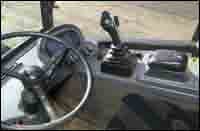In literature promoting its range of compact wheel loaders, Volvo Construction Equipment North America implies that calling these machines simply wheel loaders does not do them justice. These small models do, indeed, provide the performance of a Volvo wheel loader, says the company, but they also provide the attachment-handling capability of a skid-steer loader, and they combine these qualities with uncommon maneuverability and a roomy cab that belies their small size.
In this installment of Hands-On-Earthmoving, professional operator Tim Yednoch gives us his thoughts about one of Volvo's newest compact loaders, the L20B, the smallest machine in the company's six-model compact range. A long-time member of the International Union of Operating Engineers (Local 150), Yednoch has been an instructor at Local 150's apprentice-training facility in Plainfield, Ill., for the past 7 years.
When the 54-hp, 9,600-pound, hydrostatic-drive L20B arrived at Local 150's shop on the afternoon before our Hands-On evaluation, Yednock immediately practiced what he preaches to students by performing daily-maintenance checks.
"The engine's mounted transversely," he said, "so when you lift the tilt-up hood, all the check points are easy to reach. The grease zerks are also easily accessible, including those for the center joint. The only fittings I had to dig out were the bottom bucket pins, but that's typical of any loader—they just get full of dirt."
As he checked over the machine, Yednock also had discovered the L20B's provision for servicing its hydraulic and electrical systems. Behind an upward-opening panel just below the cab's right window are the machine's main hydraulic valve, along with pressure taps, as well as its main electrical panel, which has LED monitors that blink out next to faulty fuses and relays.
When CE editors arrived at Local 150 on the appointed day, Yednoch had already taken the L20B for a get-acquainted drive.
"So, Tim, what are your first impressions of this little Volvo?" we asked.
"I haven't run a lot of hydrostatic machines," he said, "but what I dislike about most of them is the abrupt way they stop when you lift the throttle. That's difficult to get used to, because conventional machines coast a bit when you decelerate. This one didn't seem so abrupt, though. It didn't stand you on your nose like some of them do."
Anything else generally about the machine you noticed on your initial drive?
"I think it rides good for a small machine, and I had it as fast as it would go on the flat. The suspension seat, I'm sure, contributes to the good ride. I shifted the hydrostatic system from low to high, and was impressed by the smoothness of the shift, and by how quickly the machine picked up speed. The cab is roomy, larger than I expected to find on a small machine, and the door is exceptionally wide. And there's lots of glass—visibility is excellent. I'd like a tilt wheel, which it doesn't have, but there's no problem, really, getting in and out."
How about the controls?
"Most everything is on buttons and switches here, and it's a bit difficult at first trying to remember which one to hit. When you get used to it, though, everything is handy. Initially, I kept reaching for a directional-shift lever, which is at your left hand on most loaders, but there was nothing there. You make direction shifts with a roller-type switch in the joystick, which is handy when you get the hang of it—and it's quick."
(Volvo's "multi-function" joystick in the right console controls the loader in conventional fashion, but it also houses additional controls. On the front of the grip, as Yednoch noted, are a roller switch for forward/reverse changes, plus a button for shifting between the drive system's high and low ranges, and a "neutral" button that disengages the drive system—much like the transmission disconnect in a conventional loader. On the backside of the grip is a button for engaging the L20B's differential-locking system.)
Having not had the opportunity to thoroughly read the operator's manual, Yednoch did have a question about activating the L20B's hydraulic coupler. Andy Capps, Volvo's central-region sales manager, who was on hand to answer such questions, explained first that the L20B could be fitted with either Volvo's proprietary hydraulic coupler or a universal-type hydraulic coupler that accommodates skid-steer attachments.
Since our machine had the universal coupler, said Capps, you first push the yellow button on the dash to divert flow from the machine's auxiliary-hydraulic circuit and into the coupler circuit, then you use the small auxiliary-function lever, adjacent the joystick, to activate the locks.
When Yednoch picked up a bucket with the coupler, he said that placing the L20B's instrument cluster off to the right of the steering wheel was a good design idea: "You don't have to lean forward and look over the panel to see the attachment locks."
Yednoch then took the L20B to an area in Local 150's expansive complex where a bench of material would provide a good test of the machine's digging and loading ability. Although the day was windy and dry, two previous days of rain had added considerable weight to the already heavy soil. To reach the site, the L20B had to slog through some rough going that probably would have challenged a rubber-tired skid-steer.
Yednoch used the machine to load out of the bench, reversing, then traveling forward a short distance to dump into a shallow-bodied landscaper's truck. After four or five truckloads, we asked him for his thoughts.
"An automatic bucket leveler would be a welcome feature on this machine, or at least some sort of indicator to tell you when the bucket is flat. I know Volvo tells you to look at the top of the bucket, and when it's level, then the cutting edge is about flat. But a more positive system would be helpful."
How did it dig in this heavy stuff?
"When I got into the really heavy, wet dirt too far, the boom was a bit hesitant coming up, but there was plenty of bucket rollback to break out of the pile, then the boom would come up. But, overall, it was fine in heavy digging. I used the differential lock and got full buckets every time. The machine is smooth and seems to have plenty of breakout power."
(The L20B's differential lock works on both axles. The machine must be stopped to engage the lock, and when you release the button in the joystick, the locks also release.)
How was boom-raise time approaching the truck?
"The hydraulics are fast, and the machine feels as if it has a strong lift capacity. We were using a small truck, of course, but by the time I reached it, I had the boom where I wanted it, without having to ride the brake excessively. I didn't use the neutral switch, but I can see that if you needed quicker boom raise, you could hit the switch and rev the engine. And if you did that, it would be easy to reengage the drive with the thumb switch."
(The first portion of the L20B's brake travel slows the machine by restricting hydraulic flow in its drive system. If depressed farther, it disconnects the drive and applies a mechanical brake.)
Any other thoughts about the loader's performance?
"I did notice that it seems to have a fair amount of reach, which would be useful when you're placing loads in taller trucks."
How would you compare this compact wheel loader to the larger loaders you're used to running?
"The Volvo wouldn't have the digging power of a larger machine in tough material, of course, and you'd probably have to tip the cutting edge down at a more severe angle to break up the material. But, overall, it seems very strong; it's smooth; and it's comfortable to run. Plus, you can hang attachments on the front to make it a lot of different machines."









